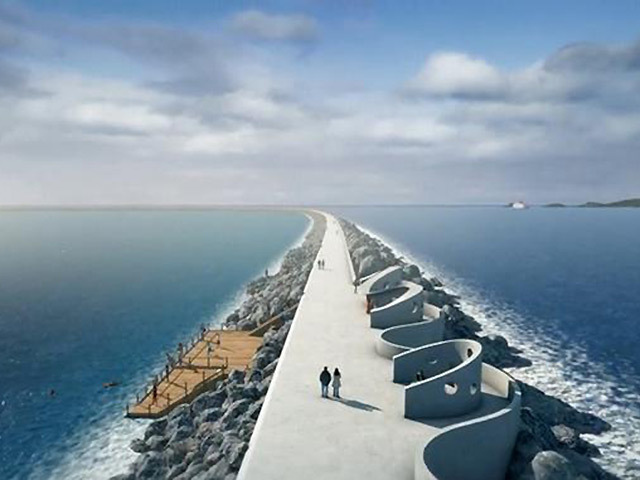
Plans have been submitted to develop the world’s first tidal lagoon energy project in the UK, which would provide renewable power for 120,000 homes for 120 years.
The developers of the £750-850 million project in Swansea Bay say their application is the first step to developing lagoon technology that could meet 10% of the UK’s electricity needs from the tides.
The scheme would involve a six-mile (9.5km) wall built around Swansea Bay, creating a lagoon in the Severn Estuary with turbines that can harness the incoming and outgoing tides to generate power 14 hours a day.
If it gets the go-ahead, the lagoon could be the first of a series of five developments around the UK coast which could generate as much as 10% of the UK’s electricity by 2023.
Tidal Lagoon Power, the company behind the project, said it was hoping that 65% of expenditure would be in the UK, boosting a homegrown supply chain and a possible future export market.
The project includes creating a 10km sea reef, the reintroduction of the native oyster to Swansea Bay, an offshore visitor centre and national triathlon and water sports facilities.
According to the developers, research as part of the project’s initial stages found that 86% of local residents were in favour of the scheme.
The Swansea Bay project would save 236,000 tonnes of carbon a year and create 1,850 construction jobs.
Some 150 long term jobs in operation and the leisure facilities would also be created while the development would also boost jobs in the wider supply chain, the company said.
Mark Shorrock, chief executive of Tidal Lagoon Power, said: “Until now, tidal energy has been heavily promoted by governments and environmentalists as an intuitive source of clean and reliable energy for our island nation, but the business response has focused on relatively small-scale tidal stream devices.
“The UK has the second highest tidal range in the world and today we are submitting an application for a development that will prove that this resource can be harnessed in a way that makes economic, environmental and social sense.
“Tidal lagoons offer renewable energy at nuclear scale and thus the investment of hundreds of millions of pounds in UK industries and coastal communities.”
And he said: “Our intention is to supply 10% of the UK’s domestic electricity by building at least five full-scale tidal lagoons in UK waters by 2023, before the UK sees any generation from new nuclear.”
Building more, larger lagoons would bring economies of scale.
 The project would expect to benefit from subsidies levied on energy bills for clean power, but Mr Shorrock said a second lagoon would require a lower level of support than offshore wind.
The project would expect to benefit from subsidies levied on energy bills for clean power, but Mr Shorrock said a second lagoon would require a lower level of support than offshore wind.
A third lagoon, he suggested, would be competitive with the support received by new nuclear plants but without the decommissioning costs and safety concerns.
And other sites where lagoons are being considered, such as the Somerset coast, could have added benefits such as flood defences.
The developers have submitted an application which will now be considered by the Planning Inspectorate.
If the application is accepted it will then be assessed with a final decision expected from the Energy Secretary and Natural Resources Wales in early 2015.
If the go-ahead is given, construction could start next year, with the first power generated by 2018, the company said.
The project is the latest plan to harness the huge tidal power of the Severn Estuary, after a separate scheme for a barrage across the estuary failed to win political support amid concerns the economic and environment case for it did not stack up.
Gareth Clubb, director of Friends of the Earth Cymru said: “Provided they meet strict environmental criteria, tidal lagoons can play a key role in building a low-carbon future, supplying clean electricity to many thousands of homes.
“With its huge coastline, the UK has plenty of potential for developing more schemes like this – along with other renewable forms of energy.
“We look forward to reading the detailed application for Swansea’s tidal lagoon, to satisfy ourselves that we can give this potentially valuable project our full support.”
Wildfowl and Wetlands Trust head of conservation policy Carrie Hume said: “A tidal power proposal should generate maximum power for minimum damage to our natural heritage.
“The Swansea Bay developers approached us for our views and have tried to minimise the impacts on the environment.
“We’d like to see other developers taking this approach to develop innovative schemes on a case by case basis along the Severn.”
RSPB special sites spokesman Sean Christian said: “We welcome the fact that the conversation about energy projects in the Severn Estuary is now focused on tidal power lagoons rather than a more damaging shore-to-shore barrage.
“This technology will have less impact on fish and other wildlife than the barrage proposals, which conservationists have spent several years fighting in the estuary, and which the Government has repeatedly rejected.
“However, lagoon technology could still have major impacts on the estuary and its wildlife, and we will need to look at the details of each lagoon proposal closely.
“We are currently working with the developers of the Swansea Tidal Lagoon to understand the impacts of their scheme and see if solutions can be found.”
Recommended for you
